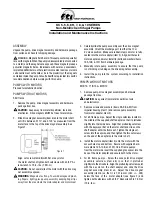
SPLIT CASE PUMP MODULE
Page 7-2
15 July, 2019
IVEK Corp.
P07R002P
7.
SPLIT CASE PUMP MODULE
7.1
DESCRIPTION (Figure 7.1)
The Split Case Pump Module, hereafter referred to as Pump Module, is comprised of a ceramic piston and cylinder set,
two castellated sleeves and a split case assembly. Certain components of the Pump Module are in the direct liquid path.
The Pump Module has been designed to be easily disassembled and detached from the Motor/Base Module for ease of
cleaning, decontamination and sterilization.
The Pump Module's piston/cylinder set provides positive liquid displacement. Table 7.1 describes the total volumetric
output of this pump.
WARNING
Never remove a safety cover while the motor is running. Moving parts are located under these covers. Physical
harm to individuals is possible.
7.2
OPERATION
When the Pump Module is mounted on the Motor/Base Module, the piston is driven by a spherical bearing mounted within
a rotating spindle. This drive arrangement imparts both reciprocating and rotary motion to the piston. The magnitude of
the piston's stroke is adjustable by varying the angle of the axis of the pump head relative to the axis of the motor drive
shaft. This displacement range is infinitely adjustable within the pump specifications (refer to Table 7.1). The displacement
adjustment is easily made and recorded as a setting taken from the Motor/Base Module's vernier scale. Repeatability of
0.1% is obtainable once the stroke length is established.
On each rotation of the piston, the ports are opened alternately and exclusively, first to the inlet and then to the outlet.
During the rotation, the limited piston flat creates the void that allows the flow from only one port at a time, positively
displacing the liquid. The piston flat acts as a rotary valve, completing one pressure stroke and one suction stroke per
revolution as the pump rotates and reciprocates synchronously.
The end of the piston is never drawn back beyond the inlet and outlet ports in normal operation. The piston flat allows only
one port to communicate with the interior chamber of the pump cylinder at any one time. The effect is positive mechanical
valving, eliminating the need for check valves under normal operations.
The pump, which cannot be driven by either inlet or outlet pressure, essentially acts as a closed valve when the unit is not
in operation.
Castellated
Sleeve
Figure 7.1 Split Case Pump Module
Split Case
Piston



































